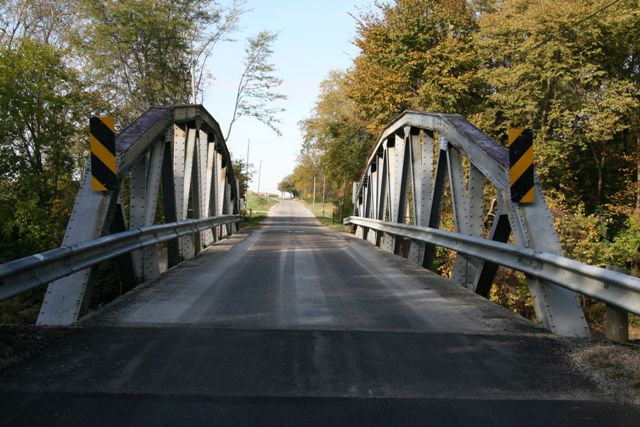We Recommend:
Bach Steel - Experts at historic truss bridge restoration.
BridgeHunter.com Phase 1 is released to the public! - Visit Now
Long Judson Road Bridge

Primary Photographer(s): Rick McOmber
Bridge Documented: July 15, 2007
Rural: Wood County, Ohio: United States
1916 By Builder/Contractor: Elkhart Bridge and Iron Company of Elkhart, Indiana and Engineer/Design: R. M. Strohl
1987
102.0 Feet (31.1 Meters)
105.0 Feet (32 Meters)
16 Feet (4.88 Meters)
1 Main Span(s)
8745625

View Information About HSR Ratings
Bridge Documentation
This bridge no longer exists!
Bridge Status: This historic bridge has been demolished and replaced!View Archived National Bridge Inventory Report - Has Additional Details and Evaluation
With a length of over 100 feet, this is a very long pony truss span. The visual result of that fact is a very tall and impressive pony truss bridge. The bridge is composed of built-up beams although there is no lattice or v-lacing except under the top chord and end post which is v-laced. The bridge is a rare surviving example of a bridge built by the Elkhart Bridge and Iron Company. Original railings do not remain on the bridge and have been replaced by Armco guardrails which are not properly mounted so as to protect the superstructure from collision damage. Properly mounted guardrails is essential not only to preserve the historic bridge, but also to ensure maximum bridge safety.
This bridge is also a relatively early polygonal Warren pony truss, since most Warren truss bridges with a polygonal top chord date to 1920 and later.
Information and Findings From Ohio's Historic Bridge InventorySetting/Context The bridge carries a 2 lane road over a stream in a sparsely developed, rural setting. Physical Description The 6-panel, 105'-long, riveted Parker pony truss bridge is supported on concrete abutments. The members are built up. The flooring system was replaced/modified using what appears to be salvaged material in 1987. There are no innovative or distinctive details. Integrity The riveted Parker pony truss bridge was designed by R. M. Strohl (plans undated) and fabricated by the Elkhart Bridge & Iron Co. (shop drawings dated 1916). Summary of Significance The Parker thru truss bridge was built in 1916 and is a later example of what was by 1916 a very common bridge type and design. The bridge is traditionally composed and exhibits no innovative or distinctive
details, other than some detailing at the gusset plates which is equally well represented by longer and/or earlier bridges. It is representative of a bridge type and design as well as methods of fabrication that had been used for
span lengths greater than 100' since the last quarter of the 19th century. Bridge Considered Historic By Survey: No |
![]()
Photo Galleries and Videos: Long Judson Road Bridge
Bridge Photo-Documentation
Original / Full Size PhotosA collection of overview and detail photos. This gallery offers photos in the highest available resolution and file size in a touch-friendly popup viewer.
Alternatively, Browse Without Using Viewer
![]()
Bridge Photo-Documentation
Mobile Optimized PhotosA collection of overview and detail photos. This gallery features data-friendly, fast-loading photos in a touch-friendly popup viewer.
Alternatively, Browse Without Using Viewer
![]()
Maps and Links: Long Judson Road Bridge
This historic bridge has been demolished. This map is shown for reference purposes only.
Coordinates (Latitude, Longitude):
Search For Additional Bridge Listings:
Bridgehunter.com: View listed bridges within 0.5 miles (0.8 kilometers) of this bridge.
Bridgehunter.com: View listed bridges within 10 miles (16 kilometers) of this bridge.
Additional Maps:
Google Streetview (If Available)
GeoHack (Additional Links and Coordinates)
Apple Maps (Via DuckDuckGo Search)
Apple Maps (Apple devices only)
Android: Open Location In Your Map or GPS App
Flickr Gallery (Find Nearby Photos)
Wikimedia Commons (Find Nearby Photos)
Directions Via Sygic For Android
Directions Via Sygic For iOS and Android Dolphin Browser
USGS National Map (United States Only)
Historical USGS Topo Maps (United States Only)
Historic Aerials (United States Only)
CalTopo Maps (United States Only)

